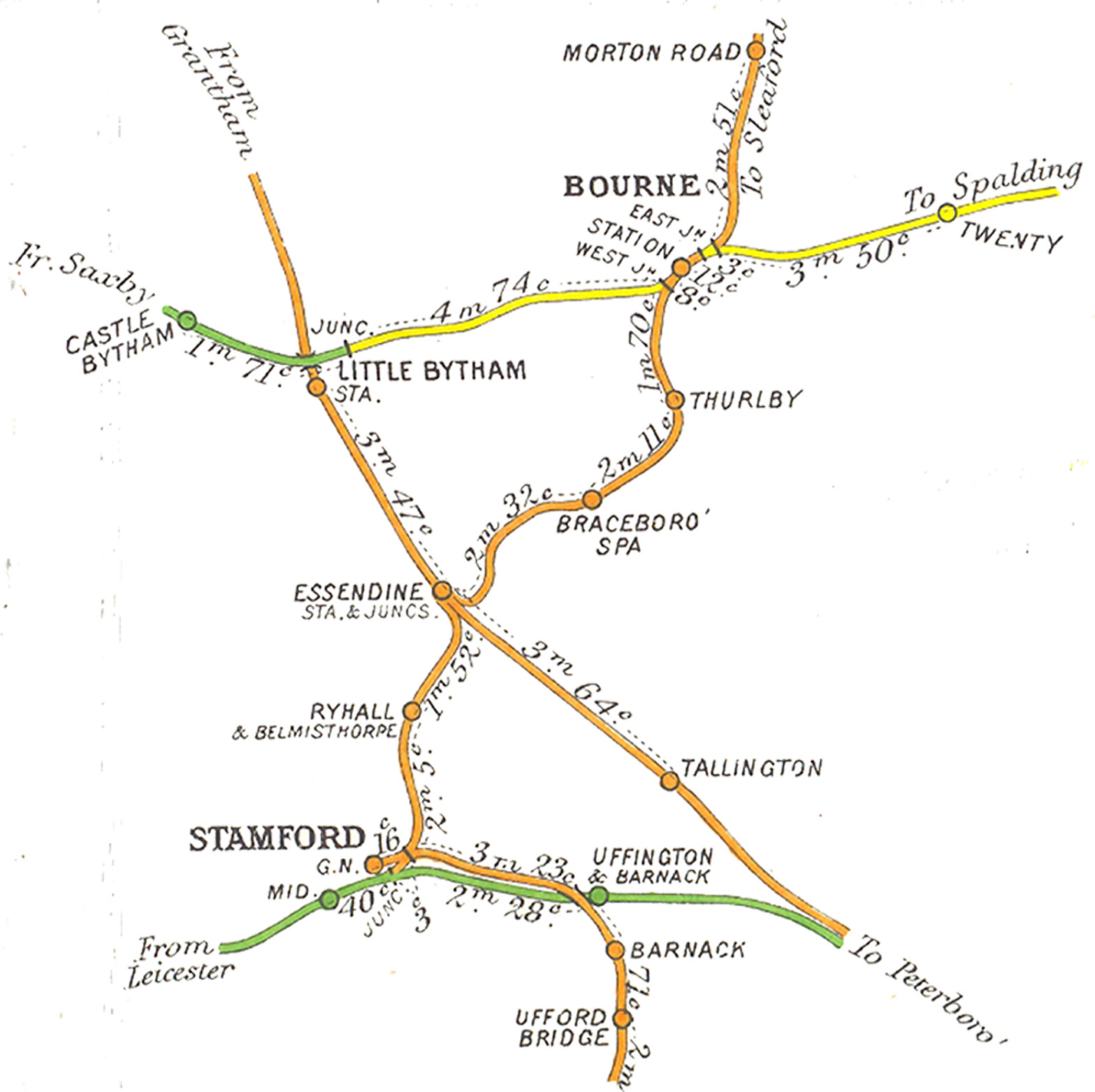|
Uffington Rural District
Uffington was a rural district in Lincolnshire, Parts of Kesteven from 1894 to 1931. It was created in 1894 from that part of the Stamford rural sanitary district which was in Kesteven (the rest forming part of either Ketton Rural District in Rutland, Easton on the Hill Rural District in Northamptonshire, or Barnack Rural District in the Soke of Peterborough). It covered the following parishes: * Barholm * Braceborough *Greatford *Stowe *Tallington *Uffington * West Deeping * Wilsthorpe It was abolished by a County Review Order The Local Government Act 1929 was an Act of the Parliament of the United Kingdom that made changes to the Poor Law and local government in England and Wales. The Act abolished the system of poor law unions in England and Wales and their boar ... in 1931, and went to form part of the South Kesteven Rural District. References *http://www.visionofbritain.org.uk/relationships.jsp?u_id=10027135&c_id=10001043 {{coord, 52.67, -0.40, dim:10000_regi ... [...More Info...] [...Related Items...] OR: [Wikipedia] [Google] [Baidu] |
Rural District
Rural districts were a type of local government area – now superseded – established at the end of the 19th century in England, Wales, and Ireland for the administration of predominantly rural areas at a level lower than that of the Administrative county, administrative counties.__TOC__ England and Wales In England and Wales they were created in 1894 (by the Local Government Act 1894) along with Urban district (Great Britain and Ireland), urban districts. They replaced the earlier system of sanitary districts (themselves based on poor law unions, but not replacing them). Rural districts had elected rural district councils (RDCs), which inherited the functions of the earlier sanitary districts, but also had wider authority over matters such as local planning, council house, council housing, and playgrounds and cemeteries. Matters such as education and major roads were the responsibility of county councils. Until 1930 the rural district councillors were also poor law gu ... [...More Info...] [...Related Items...] OR: [Wikipedia] [Google] [Baidu] |
Braceborough
Braceborough is a village in the South Kesteven district of Lincolnshire, England. It is situated off the Stamford to Bourne A6121 road, just west of the A15 as it runs between Market Deeping and Bourne. It forms part of the Civil Parish of Braceborough and Wilsthorpe. The ecclesiastical parish has equivalent boundaries to the civil parish. It is part of the Uffington Group in the Aveland & Ness with Stamford Deanery of the Diocese of Lincoln. The incumbent is Rev Carolyn Kennedy. The Grade I listed Anglican parish church is dedicated to St Margaret. It was almost entirely rebuilt in 1837.Cox, J. Charles (1916) ''Lincolnshire'' pp. 77-78; Methuen & Co. Ltd During the Second World War Braceborough Hall housed elements of the Women's Land Army; it is now a retirement home. Braceborough Spa Near Braceborough is Braceborough Spa which had its own railway station, Braceborough Spa Halt, on the independent Essendine to Bourne Railway. It became part of Great Northern Rail ... [...More Info...] [...Related Items...] OR: [Wikipedia] [Google] [Baidu] |
South Kesteven Rural District
South Kesteven was a rural district in Lincolnshire, Parts of Kesteven in England from 1931 to 1974. It was formed under a County Review Order in 1931, by the merger of the Bourne Rural District and the Uffington Rural District. It continued in existence until 1974, when it was abolished by the Local Government Act 1972, going on to form part of a larger South Kesteven South Kesteven is a Non-metropolitan district, local government district in Lincolnshire, England, forming part of the traditional Kesteven division of the county. It covers Bourne, Lincolnshire, Bourne, Grantham, Market Deeping and Stamford, Li ... non-metropolitan district. References *https://web.archive.org/web/20070930181821/http://www.visionofbritain.org.uk/relationships.jsp?u_id=10096017 {{Use dmy dates, date=October 2017 Rural districts of Kesteven Districts of England abolished by the Local Government Act 1972 ... [...More Info...] [...Related Items...] OR: [Wikipedia] [Google] [Baidu] |
Local Government Act 1929
The Local Government Act 1929 was an Act of the Parliament of the United Kingdom that made changes to the Poor Law and local government in England and Wales. The Act abolished the system of poor law unions in England and Wales and their boards of guardians, transferring their powers to local authorities. It also gave county councils increased powers over highways, and made provisions for the restructuring of urban and rural districts as more efficient local government areas. Poor Law reform Under the Act all boards of guardians for poor law unions were abolished, with responsibility for public assistance transferred to Public Assistance Committees of county councils and county boroughs. The local authorities took over infirmaries and fever hospitals, while the workhouses became public assistance institutions. Later legislation was to remove these functions from the control of councils to other public bodies: the National Assistance Board and the National Health Service. The M ... [...More Info...] [...Related Items...] OR: [Wikipedia] [Google] [Baidu] |
Wilsthorpe, Lincolnshire
Wilsthorpe is a village in the district of South Kesteven in the county of Lincolnshire, England. It is situated approximately north-east from Stamford and approximately south from Bourne. The population is included in the civil parish of Braceborough and Wilsthorpe. Originally a Chapelry in Greatford parish, Wilsthorpe was created a civil parish in 1866 and lasted until 1931 when it was abolished to create the civil parish of Braceborough and Wilsthorpe. Wilsthorpe is mentioned in ''Domesday Book'' of 1086 when it was listed as having 20 households, of meadow, of woodland, and two mills. A possible Roman villa has been located as cropmarks to the south-east of the village, and King Street is a Roman road. The church is a Grade II* listed building dedicated to Saint Faith. Built in 1715, it was restored and altered by James Fowler of Louth in 1869. In the sanctuary is a late-13th-century effigy of a knight in chain mail; perhaps a Wake family member. Hereward the W ... [...More Info...] [...Related Items...] OR: [Wikipedia] [Google] [Baidu] |
West Deeping
West Deeping is a village and civil parish in the South Kesteven district of Lincolnshire, England. The population of the civil parish at the 2011 census was 255. It is situated on the A1175 road, east from Stamford and west from Market Deeping. It is the smallest of The Deepings group of villages situated around the A1175 road. Village population is 277. The name 'Deeping' comes from the Old English ''deoping'' meaning 'deep place'. The Roman Road of King Street passes through the village and crosses the A1175. The church of St Andrew dates back to the 13th century, with further additions in 1676 and 1803 and a restoration in 1876–77, and is Early English, Decorated and Perpendicular in style. It is part of The Uffington Group of the Deanery of Stamford, in the Diocese of Lincoln. Uffingtongroup.org.uk. Retrieved 6 ... [...More Info...] [...Related Items...] OR: [Wikipedia] [Google] [Baidu] |
Uffington, Lincolnshire
Uffington is a village and civil parish in the South Kesteven district of Lincolnshire, England. The population of the civil parish at the 2011 census was 686. It is in the valley of the River Welland, between Stamford and The Deepings. Geography The village lies east of Stamford on the A1175 (previously the A16) where the low Jurassic clay and cornbrash ridge on which it stands lies or so above the level of The Fens. Uffington Park, the grounds of a country house built in 1681 by the Bertie family and demolished by fire in 1904, lies between the village and the River Welland. Subsidiary buildings of Uffington House remain. To the north-east is Casewick House, a Grade I listed building. It was a medieval house remodelled in the 17th century by the Trollope family and divided into three units and sold in the 1980s. Towards Stamford lay Newstead Priory. Newstead Mill is a Grade II listed watermill on the River Gwash; it is now converted to flats. Community The Grad ... [...More Info...] [...Related Items...] OR: [Wikipedia] [Google] [Baidu] |
Tallington
Tallington is a village and civil parish in the South Kesteven district of Lincolnshire, England. The population of the civil parish at the 2011 census was 497. It is situated east from Stamford and north-east from the centre of Peterborough. The village has around 200 houses. Geography Tallington is on the main A1175 road (formerly the A16) (for Market Deeping) which runs between Stamford and Spalding. To the west is Uffington. Tallington has a busy level crossingbr>overthe East Coast Main Line. There was once a Tallington railway station, but it is now closed. Since the 1930s there has been a plan for a Tallington bypass and bridge over the railway ; even though the village ended up making concrete bridges for many UK motorways (including much of the Yorkshire section of the M62), there has never been a bridge made for the village. Dow Mac even offered to donate a bridge to the village. From the East Coast Main Line south-east of the village, the parish boundary ... [...More Info...] [...Related Items...] OR: [Wikipedia] [Google] [Baidu] |
Greatford
Greatford is a village and civil parish in the South Kesteven district of Lincolnshire, England. It is situated west from the A15, north-east from Stamford, and south from Bourne. Greatford is noted for Greatford Hall, once the home of Francis Willis. In the 2001 Census, Greatford's population was found to be 260, increasing slightly to 268 at the 2011 census. History There are different pronunciations and spellings for this village's name, including Greatford, Gritford, and Gretford."The Village" Greatford Parish Council. Retrieved 15 August 2011 The name could be derived from its location on a gravel or 'grit' ford of the West Glen River. Greatford is listed in the 1086 '' |
Barholm
Barholm is a village in the South Kesteven district of Lincolnshire, England. It is west from the A15 road (England), A15 road, and south from Bourne, Lincolnshire, Bourne. Barholm is first recorded as "Berc(a)ham" in 1086; the name is from Old English ''beorg'' + ''hām'' or ''hamm'' and means "homestead or enclosure on a hill." Hereward the Wake, Hereward (later known as Hereward the Wake) owned land in Barholm and the nearby village of Stowe in the period before the Norman conquest of England, Norman conquest in 1066. St Martin's Church is Grade I listed. The church received a new tower during the English Civil War and an inscription with the date 1648 reads: "Was ever such a thing Since the Creation? A new steeple built In the time of vexation." Local government Barholm and Stowe is a civil parish. It is run through a parish meeting of its residents rather than a parish council, two district councillors who represent Casewick Ward on South Kesteven District Council and ... [...More Info...] [...Related Items...] OR: [Wikipedia] [Google] [Baidu] |
Kesteven
The Parts of Kesteven ( or ) are a traditional division of Lincolnshire, England. This division had long had a separate county administration (quarter sessions), along with the two other Parts of Lincolnshire, Lindsey and Holland. Etymology The word ''Kesteven'' is supposed to have derived from two root words: the Celtic ' meaning wood (compare Modern Welsh ') and the Old Norse ', a meeting place. The earliest record of the place-name is c1000 and was spelt , developing into by 1185. Administrative areas Wapentakes and Sokes Historically, Lincolnshire was divided into wapentakes, hundreds and sokes. The following made up Kesteven: * Aswardburn Wapentake * Aveland Wapentake * Beltisloe Wapentake * Boothby Graffo Wapentake * Flaxwell Wapentake * Langoe Wapentake * Lovedon Wapentake * Ness Wapentake * Winnibriggs and Threo Wapentake * Borough and Soke of Grantham * Stamford Borough Local Government Act 1888 The three parts were given separate elected county councils ... [...More Info...] [...Related Items...] OR: [Wikipedia] [Google] [Baidu] |


.jpg)
